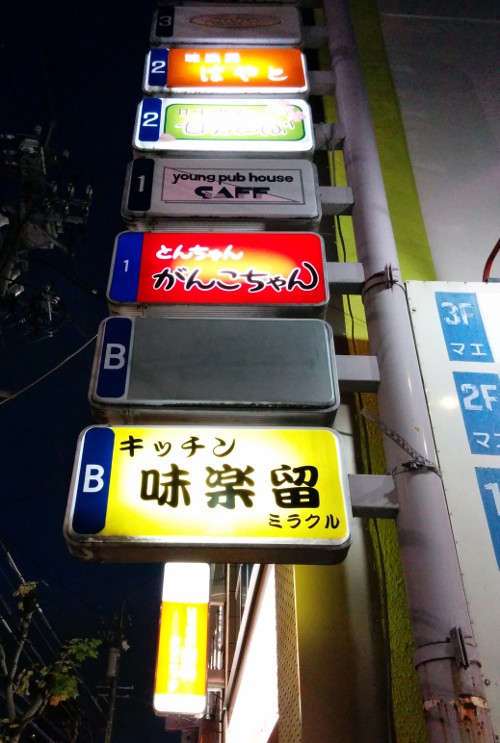Miracle
« previous post | next post »
This signpost is from a building near the subway station closest to Nathan Hopson's apartment in Nagoya:
The bottom sign is for "Kitchen Miracle". I am impressed with the kanji chosen to be read mirakuru ミラクル: 味(mi み)楽(raku らく)留(ru る), which implies, "stay [a while] (留), [enjoy the] taste (=food) (味), and have fun (楽, here as 楽しむ (tanoshimu たのしむ), "to enjoy")."
[Thanks to Nathan Hopson]

Eric TF Bat said,
December 22, 2014 @ 12:38 am
This reminds me of something I wanted to ask you, coincidentally about the word "mirakuru". In the TV series Arrow, a retelling of the story of the comic-book hero Green Arrow, there's a drug called Mirakuru that gives people super strength and also incidentally drives them mad. The name comes from a similar drug in the comics, Miraclo, invented by Rex "Hourman" Tyler in the 1940s, though no mention has yet been made of that origin on the show. I was wondering if there's an arrangement or etymology for the made-up word that might fit this definition. Any ideas?
Ethan said,
December 22, 2014 @ 1:24 am
@Eric: I know nothing about the TV series, but here it's not a "made-up word" – it's a clever way to transcribe the English word "miracle". The standard way would be the katakana characters at the lower right. The use of kanji here is a clever 2-language pun that uses the characters to represent the same English sound-approximation as the katakana, while at the same time playing with the meaning of the individual characters.
the other Mark P said,
December 22, 2014 @ 4:47 pm
What I found interesting was that they use "B" for basement. Do they not have an ideograph for "basement"?
I note also parking signs "3F" on the right. Is that because an alphabet gives an order, so making parking areas more obviously arranged. If so, does that mean Japanese children need to learn the order of the English alphabet on top of two other sets of signs for language?
David B Solnit said,
December 22, 2014 @ 5:14 pm
@the other Mark P:
Maybe a bit off-topic, but: kanji (and kana, and Chinese characters) are not ideographs. They stand for linguistic elements, not ideas.
the other Mark P said,
December 22, 2014 @ 6:13 pm
Yes, David I understand that. But I meant to include the full range of options, which includes ideographs. The Japanese "word" basement might not fit (just as it doesn't in English, so we use "B" as what amounts to an ideograph).
I suppose "B" is an ideograph to them, but it does seem rather odd.
Victor Mair said,
December 22, 2014 @ 6:16 pm
See J. Marshall Unger, Ideogram: Chinese Characters and the Myth of Disembodied Meaning (University of Hawai'i Press, 2004)
http://languagelog.ldc.upenn.edu/nll/?p=11109
esp. these comments:
http://languagelog.ldc.upenn.edu/nll/?p=11109#comment-581520
http://languagelog.ldc.upenn.edu/nll/?p=11109#comment-581520
see also:
http://languagelog.ldc.upenn.edu/nll/?p=10554#comment-558731
chris said,
December 22, 2014 @ 8:32 pm
I note also parking signs "3F" on the right. Is that because an alphabet gives an order, so making parking areas more obviously arranged. If so, does that mean Japanese children need to learn the order of the English alphabet on top of two other sets of signs for language?
I'm pretty sure the "F" there stands for "floor" and doesn't require knowing the order of the English alphabet. There is no "3E" or "3G" on the sign, only "1F", "2F", and "3F" — arranged vertically. (It does, however, require learning the Hindu/"Arabic" numbering system in addition to whatever system of numbering Japan already had. Or instead of, as the case may be.)
Why the Japanese use "F" and "B" instead of something more native, I couldn't really say — maybe it has something to do with the fact that buildings with enough stories to need that kind of labeling are, themselves, an imported concept (and technology)?
JQ said,
December 23, 2014 @ 1:43 am
I can't speak for mainland China but in other Chinese-speaking places, G and B are also used on lift/elevator buttons and floor/storey/level signs.
Thitherflit said,
December 23, 2014 @ 3:57 pm
Alphabetic letters ("roomaji") are a normal part of the written Japanese language. Comic books aimed at elementary school students assume familiarity with roomaji. Kids learn how to romanize their names and addresses early in elementary school. Cell-phone texting starts with roomazi input.
Wentao said,
December 23, 2014 @ 5:32 pm
1F, 2F and B are used all over Mainland China too. Interestingly for basements the order of letter and number is reversed, for example B1, B2. G shows British influence and is probably popular in Hong Kong. Most buildings I've been to just starts with 1.
Also, being a speaker of Chinese, my first reaction to 味樂留 is to translate it as "the joy of taste remains".
Ron said,
December 25, 2014 @ 1:21 am
2F, 3F, etc. are used on signage for Korean as well as Japanese businesses in NYC.
BTW, It's been a while since I visited Japan, but I remember seeing sign boards on buses and (I think) on elevators that used Arabic numerals for stops/floors except for 6 and 9, which were in kanji. I assumed they were considered so similar as to invite confusion – something I could relate to while I was trying to learn kana.